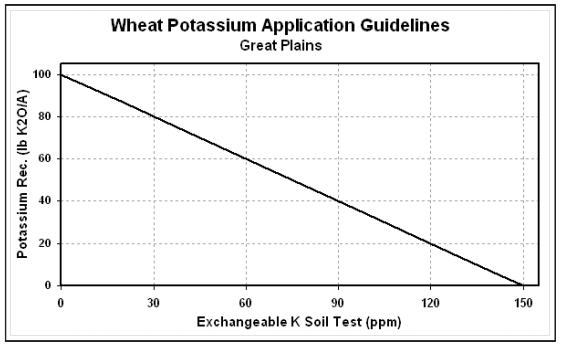Wheat is less responsive to potassium than phosphorus, and deficiencies have not been an issue for most of the Great Plains. For winter wheat, potassium shortages are most likely in the eastern portion of the region (e.g., eastern Oklahoma, eastern Kansas) and on sandy soils in other areas. About 0.3 pounds of K2O are removed in each bushel of wheat. Greater amounts of potassium are removed if the wheat is pastured or if forage crops are included in the rotation.
Potassium is different from most of the essential nutrients in that it is not a part of any structural component in wheat. As a soluble ion in plant sap, potassium is required for the activation of many enzymes. Additionally, potassium plays major roles in photosynthesis, metabolism, and many other essential plant processes.
K Deficiency Symptoms
The critical period for adequate potassium nutrition for wheat is during the early growth and development stages, when the wheat plant has a small root system and a relatively large need for potassium. Since potassium is involved in a host of plant processes, a deficiency of potassium results in retarded leaf development and stunted growth. Later, deficiencies of potassium in wheat result in increased susceptibility to lodging. Shortages of potassium have also been reported to increase the incidence and severity of several wheat diseases.
Determining K Application Rate
A sound soil testing program is the best tool available for helping wheat producers identify areas likely to be deficient in potassium. Soil testing does not identify the amount of "available" potassium present in the soil, but provides an index value which, when properly interpreted, provides a good estimate of the soil’s ability to supply potassium to the developing wheat plant. Rate recommendations are developed by relating the soil test index to research, geographic location, and other location specific factors.
Figure 5.12 Fertilizer K recommendations.

Figure 5.12 provides general guidelines for fertilizer K recommendations for the Great Plains hard wheat region. These sufficiency approach guidelines are not exact for each state but should be close. On the average, they should generally provide for optimum economic returns in the year of application.
K Application Method
Potassium is considered to be relatively immobile in soils and moves very little with water. As a result, fertilizer K applications should be made prior to planting and incorporated into the root zone if tillage is employed. Potassium applications should be made prior to the deepest tillage operation to allow for maximum incorporation.
There is little wheat research information available on the effectiveness of deep banding potassium prior to planting. However, it would be expected to perform as well as broadcasting and maybe better on low K soils with shallow incorporation. Potassium fertilizers can be placed in direct seed contact if the rates are kept low. Guidelines for the maximum amount of fertilizer that can normally be placed in direct seed contact are based on the amount of nitrogen and potassium in the fertilizer material (N and K20) (Figure 5.11). If excessive amounts of these nutrients are placed with the seed, germination can be delayed or prevented.

